 Leading Blog | Posts by Month |
 Leading Blog | Posts by Month |
09.30.21

LeadershipNow 140: September 2021 Compilation
See more on
Posted by Michael McKinney at 04:01 PM

Leading Thoughts for September 30, 2021
IDEAS shared have the power to expand perspectives, change thinking, and move lives. Here are two ideas for the curious mind to engage with: Mark Sanborn on why culture matters: “Culture is a corporate immune system that protects against variance, decline, or abandonment by identifying and combating threatening forces like toxic partners, disjointed processes, and bad decisions.” Source: The Intention Imperative Thomas Berry on the need for a new story: “It’s all a question of story. We are in trouble just now because we do not have a good story. We are in between stories. The Old Story — the account of how the world came to be and how we fit into it — is not functioning properly, and we have not learned the New Story.” Source: The New Story: Comments on the Origin, Identification and Transmission of Values Look for these ideas every Thursday on the Leading Blog. Find more ideas on the LeadingThoughts index.
Posted by Michael McKinney at 09:07 AM
09.24.21

Why Content Isn’t King in Leadership Communications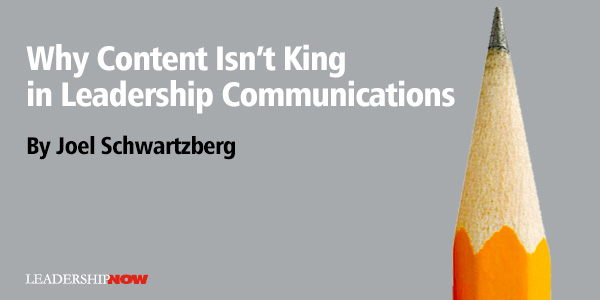
SOME of my executive clients believe, instinctively, that content is king. They maintain that “useful information” is a crucial driver of effective leadership—that their job is primarily to educate and inform their teams with facts and figures. As a result of this information-centric mindset, these leaders:
This inclination to inform may come from believing that information is inherently influential, whereas messages of inspiration are shallow and fluffy. But think back to the last time a communication inspired you. Were you inspired by long paragraphs or a memorable point? By content or commitment? By details or dedication? By a book’s table of contents or its blurb? In each of these examples, the former informs, and the latter inspires. I’m not saying information isn’t valuable. It is. Information may critically educate and enlighten. It also fills in gaps in understanding and provides essential context and updates. But while information informs, it doesn’t typically inspire. The Greatest Communicators Pair Knowledge with Inspiration Executive communication coach and author Laurie Schloff, whose clients include Bain Capital, Fidelity Investments, and Allstate, says that although many of her clients are experts in their fields, their greatest communication successes pair knowledge with inspiration. “One of my clients tended to focus on facts, research, and statistics about their product’s ingredients, which was interesting to them but overwhelming and boring to their audience of prospective customers,” Laurie told me. “With coaching, these executives shifted the focus of their communications from merely informative descriptions of their product to influential and inspiring messages about the health, well-being, and environmental impact of the product, resulting in a measurable increase in online sales.” While subject matter experts are qualified to share content, leaders have the official requirement of inspiring a team through clear and succinct expressions of hope, vision, and purpose. What might pairing information and inspiration look like in your business? Here are a few examples: “These statistics indicate where we should be focusing our efforts in the fourth quarter.”
“These three tactics will drive us toward our goal of becoming a much more diverse and inclusive organization.”
“Understanding how we got started gives us the best clues on where we should go next.”
Three Questions to Keep Your Communications on Target To ensure you’re focusing on inspiration—and not just information—in every communication, ask yourself these three questions:
Ultimately remember that you’re a leader, not simply a subject matter expert. When you focus on inspiration, not just information, you’ll find yourself engaging and inspiring your teams to follow your lead as well as your content.  
Posted by Michael McKinney at 07:48 AM
09.23.21

Leading Thoughts for September 23, 2021
IDEAS shared have the power to expand perspectives, change thinking, and move lives. Here are two ideas for the curious mind to engage with: Alan Mulally on running a business in the midst of a crisis: “Running a business is a design job. You need a point of view about the future, a really good plan to deliver that future, and then relentless implementation. Source: American Icon: Alan Mulally and the Fight to Save Ford Motor Company Larry Bossidy and Ram Charan on the need for leaders to create an organization that can confront reality: “Exercising the power of realism requires an open and inquisitive mind, intense curiosity, the intellectual ability to sort out complexity, the ability to persuade others, and—undergirding it all—the courage of inner strength. People who lack these qualities can’t be considered leaders. They should look for other work.” Source: Confronting Reality: Doing What Matters to Get Things Right Look for these ideas every Thursday on the Leading Blog. Find more ideas on the LeadingThoughts index.
Posted by Michael McKinney at 07:11 AM
09.20.21

What Does Equitable Leadership Look Like?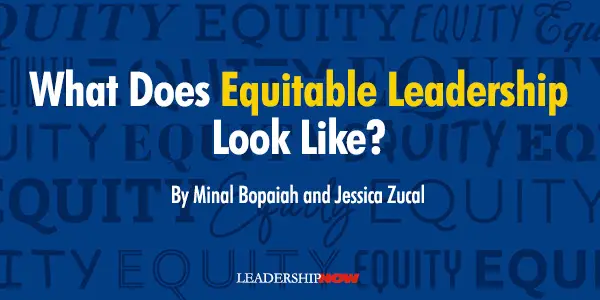
DURING the pandemic, one of us became a bit of a Star Trek fan. Minal was never really into science fiction, but she ran out of shows to watch and found herself intrigued when Stacey Abrams, who is famously a Trekkie, said that Voyager was her favorite Star Trek show, even though Deep Space Nine is considered the political allegory. Still, Abrams cited Voyager, and we can’t help thinking it was because of Captain Janeway. In Voyager, women finally had a realistic representation of female leadership aboard a Star Trek vessel, one that was determined and decisive but also empathic and willing to listen. Still, Janeway doesn’t seem like such a big deal until Minal had finished watching all the Voyager episodes and decided to dip into Star Trek: The Next Generation (referred to as TNG among Trekkies, we’re told). The first season is almost shocking in how Patrick Stewart’s Jean-Luc Picard carries himself. He’s brash and bossy and vents his frustration by shouting at children, particularly poor Wesley. In Picard, the recent revival of the Star Trek franchise, it’s clear the character evolves since season one of TNG. But we don’t think Captain Janeway would need to evolve as much if they revived her character. In fact, she’s almost a prescient paragon of what good leadership looks like in the 21st century. For decades, outdated models of Western leadership have prevailed, primarily centering White culture and male energy: someone who’s certain of himself, who has all the answers, who takes up space, shows no weakness, and knows how to win. But in a world turned upside down — by a pandemic, by climate change, by a reckoning with systemic injustice — what does winning even look like now? Leaders have been getting an inkling that things are changing, that the old tools aren’t working. They have tried to lead their staff through these changes by emphasizing we are more alike than different, that anyone who works hard can succeed here, and have been befuddled when staff respond with outrage or anger. So what exactly is going on? The definition and expectations of leadership have changed. Talented staff no longer want a general leading them into battle; they want a coach nurturing the best out of each of them. They want someone with the courage to be vulnerable and say, “I don’t know, but I’m committed to figuring it out with you.” They want an equitable leader. Someone who sees the system. Someone who is not tolerant of difference but rather so comfortable with it that they are willing to embrace it and make it a feature, not a bug of the workplace. They want someone who understands that great organizations encourage everyone to play to their strengths instead of insecurely asking everyone to fit into a mold of the “ideal” employee. However, our brains are wired to feel threatened by difference. In The Power Manual, Cyndi Suarez writes: The concept of difference is central to interactions in relationships of inequality. Humans have used differences to value, divide, and structure society—as with race, gender, class, age, and sexuality. One’s relationship to difference impacts one’s interactions, either reinforcing these structures of value or interrupting them. The supremacist approach to power offers two options for dealing with difference: ignore it or view it as cause for separation. A liberatory approach views differences as strengths and entertains interdependence as an option. How does one begin to nurture a liberatory approach to power? By examining your relationship to difference. Not surface-level differences—like a disagreement in approach or process to employ, the kind of difference that challenges your worldviews, your beliefs, and values. Leaders must navigate and embrace the latter to create inclusive and equitable environments where everyone thrives. And as Jessica has discovered through her work coaching leaders, this requires a higher degree of emotional intelligence, specifically, emotional self-awareness and the ability to self-regulate in the moment. The good news is you can build these muscles with intentional and consistent practice. Normalizing discomfort for yourself and your organization is critical. Why? Because experiencing deep differences often equates to deep discomfort, which triggers your brain’s fight or flight mechanism. In this mode, critical reasoning goes offline. You react out of habit verse skillfully responding from a place of choice. The work of the equable leader is to thoughtfully respond in the face of discomfort and to demonstrate openness for deep difference. Equitable leaders are also skilled at seeing systems and understanding interdependence. While valuing difference is the first step in the process of developing “system sight,” leaders can hone their vision by understanding their own relationship to the systems they are in. The tool Minal uses to facilitate this understanding with leaders is the Group Identity Wheel, developed by DEI practitioners and executive coaches Sukari Pinnock-Fitts and Amber Mayes. The wheel helps individuals understand themselves in all their complexity and positions their identity in relation to systems and power. It also allows them to understand both their marginalization and their privilege. This is vital to being an engaged and equitable leader. If a leader is interested in being an ally to people without the same level of privilege, then they must ask themselves, “How can I lift up the voices that may be struggling to be heard over mine in this organization?” This can be uncomfortable, which is why emotional intelligence is critical, particularly the stamina to do difficult things. It can be tempting to duck one’s head in the sand and simply believe that the outside world will not intrude upon your company. But ignoring reality makes you a poor role model for the courageous conversations we need to have if we really want to design a more equitable world where everyone thrives.  Jessica Zucal is a Senior Principal with Evans Consulting. As a change and transformation expert she works with leaders at the individual, team, and organization levels to build capacity for change and establish enabling conditions for success. Jessica is a NeuroLeadership trained coach and certified EQ-I 2.0 practitioner. 
Posted by Michael McKinney at 07:52 AM
09.16.21

Leading Thoughts for September 16, 2021
IDEAS shared have the power to expand perspectives, change thinking, and move lives. Here are two ideas for the curious mind to engage with: Geoff Tuff and Steven Goldbach on the need for flexible thinking: “We must dispel the notion that strong leaders don’t change their positions … or, dare we say, learn. Flipflopping when you have new information – flexing your thinking in an explicable way – is absolutely a hallmark of effective leadership in the face of accelerating change. Source: Provoke: How Leaders Shape the Future by Overcoming Fatal Human Flaws Historian Adrian Goldsworthy on concerns over the growth of organizations: “It is only human nature to lose sight of the wider issues and focus on immediate concerns and personal issues.… All human institutions, from countries to businesses, risk creating a similarly short-sighted and selfish culture. Source: How Rome Fell: Death of a Superpower Look for these ideas every Thursday on the Leading Blog. Find more ideas on the LeadingThoughts index.
Posted by Michael McKinney at 07:03 AM
09.13.21

A Minute to Think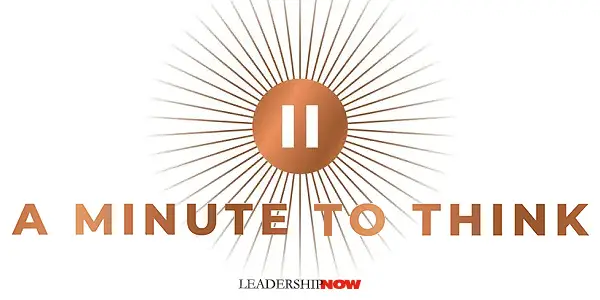
WE ALL NEED white space – open, unassigned time. We need it for better relationships, mental health, and better productivity. Juliet Funt writes in A Minute to Think, “without space, we can’t sustain ourselves.” It is the missing element in our lives, and we need to get it back. Funt suggests that first, we need to take strategic pauses to recuperate, reduce, reflect, and construct. They help us to separate. When you can’t take long stretched of pen thinking time, Funt uses what she calls the Wedge. “The Wedge is a small portion of white space inserted between two activities. It’s used specifically to pry apart actions or events that without it would have been connected.”
What keeps us from doing this are the Thieves of Time. “Four key drivers propel companies, teams, and human beings at work: Drive, Excellence, Information, and Activity. Despite being positive and helpful to us in their basic nature, these forces are also the biggest reason white space withers.” When taken to extremes, they reduce our effectiveness. They look like this: We mindlessly accept a meeting invite because we are driven. (Associated with burnout and overdrive)
You deal with these excess use of these strengths by asking the following Simplification Questions: Drive – when it turns into overdrive – needs to hear: Is there anything I can let go of? She also goes into using the Wedge to deal with the mirage of hallucinated urgency. The kind of urgency that we manufacture and causes us to “constantly and thoughtlessly interrupt our colleagues” and the kind of urgency that others place on us. Start to deal with it by putting a Wedge between what comes to mind and anything we do about it. Funt reveals to us in A Minute to Think the core issues that invite the busyness into our lives and then provides us with practical applications to defeat them. It is geared to working professionals, but people young and old, working or not, deal with these same issues that diminish the quality of their lives. The busyness mindset that we have unintentionally adopted leads to shallow thinking, the acceptance of other people’s thinking, and the knee-jerk reactions that are so prevalent today. The answer to our collective busyness is to reclaim our days by freeing up time to think, process, and create. With the Busyness Test, you can take a closer look at your day-to-day activities and habits to help you learn how to uncover more of this crucial space for creativity and strategic thinking. 
Posted by Michael McKinney at 07:44 PM
09.10.21

Elon Musk: In His Own Words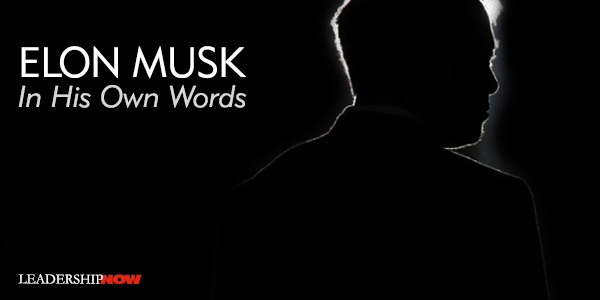
ELON MUSK is a polarizing figure. In part, because he thinks differently than most people. At a 2017 World Government Summit, he once told an audience, “Some people think I’m an alien.” His raw ideas may sound irrational, but in time they seem obvious — even to his critics. Editor Jessica Easto has compiled his thoughts in Elon Musk: In His Own Words. Easto has organized the book into three parts: Getting Started, Growth, and Wit, Wisdom, and Personal Values. Here are several: ☙ I think I would make far fewer mistakes [if I were to go back in time and talk to my 20-year-old self], like, “Here’s a list of all the dumb things you’re about to do. Please do not do them.” It’d be a very long list. ☙ Do you have the right axioms, are they relevant, and are you making the right conclusions based on those axioms? That’s the essence of critical thinking, and yet it is amazing how often people fail to do that. I think wishful thinking is innate in the human brain. You want things to be the way you wish them to be, and so you tend to filter information that you shouldn’t filter. ☙ I do think a good framework for thinking is physics, you know, the first principles reasoning. What I mean by that is boil things down to their fundamental truths and reason up from there as opposed to reasoning by analogy. Through most of our life, we get through life by reasoning by analogy, which essentially means kind of copying what other people do with slight variations. And you have to do that, otherwise mentally you wouldn’t be able to get through the day. But when you want to do something new, you have to apply the physics approach. Physics has really figured out how to discover new things that are counterintuitive, like quantum mechanics; it’s really counterintuitive. ☙ A lot of times people think creating companies is going to be fun. I would say it’s not. It’s really not that fun. There are periods of fun, and there are periods where it’s just awful. Particularly if you’re the CEO of the company, you actually have a distillation of all the worst problems in the company. There’s no point in spending your time on things that are going right, so you only spend your time on things that are going wrong.... I think you have to feel quite compelled to do it and have a fairly high pain threshold. ☙ It’s better to approach this [building a company] from the standpoint of saying—rather than you want to be an entrepreneur or you want to make money—what are some useful things that you do that you wish existed in the world? ☙ Fundamentally, if you don’t have a compelling product at a compelling price, you don’t have a great company. ☙ Things move as fast as the least lucky and least competent supplier. Any natural disaster you care to name—all of those things have happened to our suppliers. The factory has burned down, there’s been an earthquake, there’s been a tsunami, there’s been massive hail, there’s been a tornado, the ship sank, there was a shoot-out at the Mexican border—no kidding. That delayed trunk carpet. ☙ If we don’t succeed, then we will be certainly pointed to as a reason why people shouldn’t even try for these things. So I think it’s important that we do whatever is necessary to keep going. ☙ Always take the position that you are, to some degree, wrong, and your goal is to be less wrong over time. ☙ You should actually take the approach that the constraints that you are given are guaranteed to be some degree wrong.… The counterpoint would be that they're perfect [which is never].... Question your constraints. It does not matter if the person handing you those constraints won a Nobel Prize—even Einstein was wrong some of the time. ☙ I have no problem with negative feedback, nor do I have a problem with critical reviews. If I had a problem with critical reviews, I would spend all my time battling critical reviews. There have been hundreds of negative articles—hundreds—and yet I’ve only spoken out a few times. I don’t have a problem with critical reviews, I have a problem with false reviews. ☙ The first step is to establish that something is possible; then probability will occur. ☙ As you get older, your obligations increase. And once you have a family, you start taking risks not just for yourself but for your family as well. It gets much harder to do things that might not work out. So now is the time to do that—before you have those obligations. I would encourage you to take risks now; do something bold. You won’t regret it. ☙ I just want to emphasize that sometimes—in fact, most of the time—I get way too much credit or attention for what I do. I’m just the visible element. But the reason those companies are successful is because we have extremely talented people at all levels that are making it happen. ☙ Honestly, I really am just trying to do the most amount of good with the time that I have on this earth. And, you know, not always succeeding, but that’s the goal. ☙ Really should be a rule that oatmeal-raisin cookies can’t look too much like choc chip. Doppelgänger cookie trickery! 
Posted by Michael McKinney at 10:47 AM
09.09.21

Leading Thoughts for September 9, 2021
IDEAS shared have the power to expand perspectives, change thinking, and move lives. Here are two ideas for the curious mind to engage with: Former vice president and corporate controller at The Boeing Company, Laurette Koellner, on our responsibility to self-empower and self-deploy: “No one asked Amelia Earhart or Charles Lindbergh to do a solo flight across the Atlantic. No one asked Bill Boeing to build an airplane. They did these things because they wanted to. They did them because they wanted to open new frontiers. Similarly, we, as individuals, must decide how we are going to expand frontiers for ourselves — and for others who are working with us or for us. To do that, we must be prepared to do battle from time to time with the internal bureaucracy in our organizations. But even more than that, we have to be prepared to fight against our own inertia — or what one poet described as ‘mind-forges manacles.’” Source: Speech, Managing Your Career: The Ultimate Solo Flight Author and writing teacher Julia Cameron on what it takes to improve: “There will be many times when we won’t look good—to ourselves or anyone else. We need to stop demanding that we do. It is impossible to get better and look good at the same time. Source: The Artist’s Way Look for these ideas every Thursday on the Leading Blog. Find more ideas on the LeadingThoughts index.
Posted by Michael McKinney at 07:26 AM
09.06.21

The Power of Pressure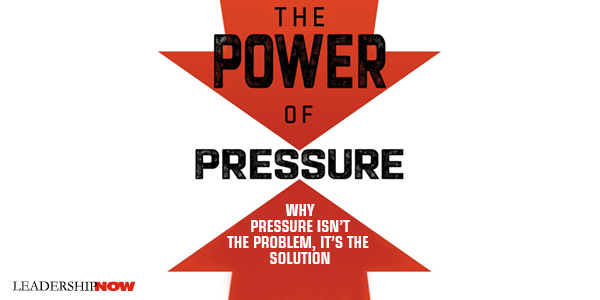
SCOTTISH philosopher Thomas Carlyle is said to have written, “No pressure, no diamonds.” And it’s true. We need to rethink how we think of pressure and how we manage it. In The Power of Pressure, Dane Jensen says, “Pressure isn’t just a nasty by-product of life, it’s an essential input into high performance. A life well-lived requires pressure.” If we can link pressure to growth, we have a great foundation to work from. So, while most of us try to eliminate or avoid pressure, maybe we need to see it as an ally. Jensen provides the understanding to do just that. He says, “pressure has patterns, and those patterns repeat.” What creates pressure is the need to do something, and that distinguishes it from other states like stress, fear, or grief. Unfortunately, just when we feel the need to do something, “our body’s default response to pressure robs us of the very abilities that can most help us manage our response to pressure.” That’s the paradox of pressure. We can become so narrowly focused under pressure that our ability to process information shrinks, and our ability to absorb helpful information diminishes. Over the long haul, if we stay in this high-pressure state, this narrow focus can become our brain’s default. So, we need a strategy. Two Kinds of Pressure Broadly speaking, there are peak pressure moments — “short, violent bursts of extreme importance and uncertainty” — and there is pressure over the long haul — “periods of grinding volume mixed with importance and uncertainty along the way.” To manage them well, we need to respond differently to each. Peak pressure moments are those that have a beginning and an end and “with a clear range of outcomes” like a race, a test, or a speech. When the moment is over, so is the pressure. “In peak pressure moments, the goal is simple: perform.” It is about “performing to the peak of your abilities instead of shrinking from the moment.” Long haul pressure is different. It can be pressure leading to a peak pressure moment, or, more often, it can simply exist. “This type of long haul can come on gradually, as additional sources of pressure are slowly layered on, one by one, until you realize you are no longer sleeping well at night or are feeling emotionally overwhelmed, unable to focus.” Jensen has identified three factors common to all pressure that exist in some combination: high importance, high uncertainty, and high volume. Together they form the Pressure Equation: PRESSURE = IMPORTANCE x UNCERTAINTY x VOLUME Importance has to do with the importance of the outcome. If you see the outcome of a situation as important, it will create some kind of pressure. But combined with uncertainty, it becomes intense pressure. Volume is what makes pressure relentless — the volume of importance. And we can all relate (well, most of us) to this from an example in the book: No team of people, no matter how capable or well-meaning, can truly attend to 189 things — which means that inevitably some of these important, uncertain items will migrate to the periphery, creating pressure each time you think of them and feel the sting of guilt over there neglect. With this in mind, we need to become what Jensen calls Pressure Ambidextrous. That is to say, learning to be “better at both performing in peak pressure moments and approaching the long haul with a sense of challenge, commitment, and motivation.” This is where his Power of Pressure Model is helpful.
Jensen takes six chapters to explain the strategy for each type of pressure and how we can best use it to our advantage. Each chapter has fresh, well-thought-out perspectives, behaviors, and insightful questions to guide us through the model. He gives this overview of each strategy as it relates to the two pressure types: Long Haul Importance: Connect with why it matters. Over the long haul, navigating importance is about creating a clear line of sight from the day-to-day grind to what matters most to you. It’s about keeping importance front and center in the midst of all the ups and downs that accompany any busy life. When our daily decisions become disconnected from what matters to us for too long, it is hard to sustain a sense of commitment to the journey. Jensen says that much of this boils down to attention control. “The ultimate solution to the pressure equation is being able to consciously and deliberately direct the spotlight of our attention to focus on the thoughts, beliefs, and habits that support us rather than undermine us.” The Power of Pressure is an outstanding book, and you can find whitepapers to support these ideas on his website. 
Posted by Michael McKinney at 03:20 PM
09.03.21

Leading Views: Find Your Voice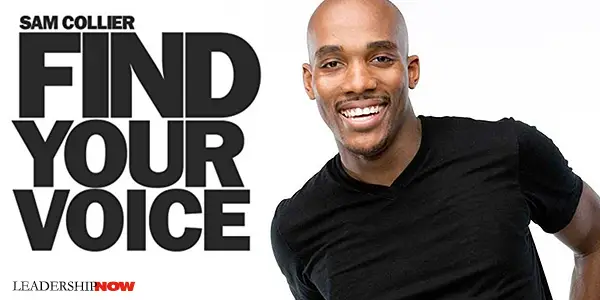
When you’re unaware that someone or something is influencing you, it leaves you in a very dangerous position. But when you can see it, that’s when you begin to access the power of influence in your life. Then you begin to manage it. And when you can manage it, the game changes! Collier focuses on three categories of people that have the ability to change your life right now: friends, leaders, and followers. Each can influence us through our thoughts, decisions, and atmosphere (culture). We should choose our leaders carefully. “Find a voice that can lead you to success.” To that end, “not every leader should be followed.” If they are not leading where you want to go, don’t follow. In choosing a leader, remember:
A great leader can help you find your voice. In the same way, you can do the same for others and find your voice through your leadership. Ask yourself the following questions: Who is following me? 
Posted by Michael McKinney at 10:38 AM
09.02.21

Leading Thoughts for September 2, 2021
IDEAS shared have the power to expand perspectives, change thinking, and move lives. Here are two ideas for the curious mind to engage with: Consultant Jeff Davidson on the need for breathing space: “When your brain is always engaged, when your neurons are always firing, when you find yourself in a continual mode of reacting and responding, instead of steering and directing, the best and brightest solutions that you are capable of producing rarely see the light of day. Source: Speech, Taking Back Control of Our Days Philip Yancy on how art can help turn us from the world’s frivolities and given us time for reflection: “Compared to any other time in history, we moderns scream and shout at each other. Listen to the music on any Top 40 station. Visit a museum of contemporary art. The world today contains no subtlety, no silence, no spaces. Source: First Things, “What Art Can—and Can’t—Do” February 2009 Look for these ideas every Thursday on the Leading Blog. Find more ideas on the LeadingThoughts index.
Posted by Michael McKinney at 08:40 AM
09.01.21

First Look: Leadership Books for September 2021Here's a look at some of the best leadership books to be released in September 2021. Don't miss out on other great new and future releases not listed here.
In The Art of Statistics, world-renowned statistician David Spiegelhalter shows readers how to derive knowledge from raw data by focusing on the concepts and connections behind the math. Drawing on real world examples to introduce complex issues, he shows us how statistics can help us determine the luckiest passenger on the Titanic, whether a notorious serial killer could have been caught earlier, and if screening for ovarian cancer is beneficial. The Art of Statistics not only shows us how mathematicians have used statistical science to solve these problems — it teaches us how we too can think like statisticians. We learn how to clarify our questions, assumptions, and expectations when approaching a problem, and — perhaps even more importantly -- we learn how to responsibly interpret the answers we receive.
Most organizations have created always-on work contexts that are burning people out and hurting performance rather than delivering productivity, innovation and engagement. Collaborative work consumes 85% of employees' time and is drifting earlier into the morning, later into the night, and deeper into the weekend. The dilemma is that we all need to collaborate more to create effective organizations and vibrant careers for ourselves. But conventional wisdom on teamwork and collaboration has created too much of the wrong kind of collaboration, which hurts our performance, health and overall well-being.
In Provoke: How Leaders Shape the Future by Overcoming Fatal Human Flaws, renowned strategy consultants and best-selling authors Geoff Tuff and Steven Goldbach deliver an insightful exploration of how people tend to act tentatively in the face of uncertainty and provide the tools we need to do things differently. Tuff and Goldbach offer up a compelling argument for the proposition that taking a "wait and see" approach is the exact opposite of what helps visionary leaders change the world. Drawing on principles from business and behavioral economics, the book shows readers from all walks of life how to provoke action as a mechanism to advance.
Your personal goals need a long-term strategy. Just as CEOs who optimize for quarterly profits often fail to make the strategic investments necessary for long-term growth, the same is true in our own personal and professional lives. We need to reorient ourselves to see the big picture so we can tap into the power of small changes that, made today, will have an enormous and disproportionate impact on our future success. We need to start playing The Long Game. Everyone is allotted the same twenty-four hours — but with the right strategies, you can leverage those hours in more efficient and powerful ways than you ever imagined. It's never an overnight process, but the long-term payoff is immense: to finally break out of the frenetic day-to-day routine and transform your life and your career.
For a dozen years as one of the world’s most admired CEOs, Indra Nooyi redefined what it means to be an exceptional leader. The first woman of color and immigrant to run a Fortune 50 company — and one of the foremost strategic thinkers of our time — she transformed PepsiCo with a unique vision, a vigorous pursuit of excellence, and a deep sense of purpose. Now, in a rich memoir brimming with grace, grit, and good humor, My Life in Full offers a firsthand view of Nooyi’s legendary career and the sacrifices it so often demanded.
Iteration rules product development, but it isn’t enough to produce dramatic results. This book champions Radical Product Thinking, a systematic methodology for building visionary, game-changing products. When we iterate without a clear vision or strategy, our products become bloated, fragmented, and driven by irrelevant metrics. They catch “product diseases” that often kill innovation. Radical Product Thinking (RPT) gives organizations a repeatable model for building world-changing products. The key? Being vision-driven instead of iteration-led. Radhika Dutt guides readers through the five elements of the methodology (vision, strategy, prioritization, execution and measurement, and culture) to develop a clear process for translating vision into reality, and turning RPT skills into muscle memory.
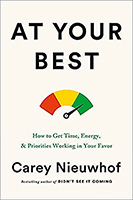 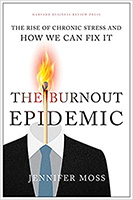 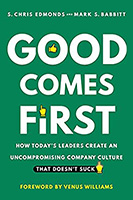
 Build your leadership library with these specials on over 28 titles. All titles are at least 40% off the list price and are available only in limited quantities. “There’s a lot to learn from the right leadership books. If you think you know it, think again. Ask those you trust what books have inspired them, and dig in. Always have at least one book going.” — Kent Taylor, Made From Scratch
Posted by Michael McKinney at 06:36 PM
|
BUILD YOUR KNOWLEDGE


How to Do Your Start-Up Right STRAIGHT TALK FOR START-UPS 
Grow Your Leadership Skills NEW AND UPCOMING LEADERSHIP BOOKS 
Leadership Minute BITE-SIZE CONCEPTS YOU CAN CHEW ON 
Classic Leadership Books BOOKS TO READ BEFORE YOU LEAD |
|